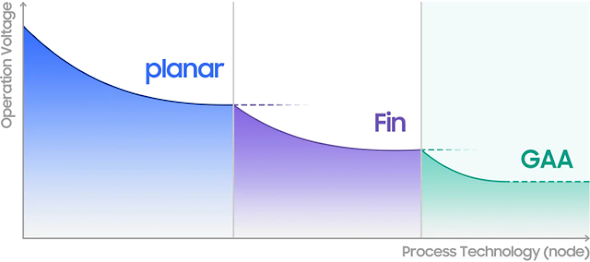Samsung has been "voicing the platform" for GAA transistors for a long time
In June 2021, Samsung was the first to announce that its 3nm process based on GAA technology had been successfully taped out.
Then in October 2021, Samsung announced that it would lead TSMC to produce the 3nm GAA process in the first half of 2022.
In April of this year, the yield rate of Samsung's 3nm process based on FGAMALL GAA transistors was only 10%-20%, far lower than expected, which means that the company needs to pay higher costs.
In May of this year, news came out again in the industry that Samsung's 3nm yield problem has been resolved, and the 3nm GAA process will be mass-produced as scheduled.
In June, Samsung's 3nm process has entered experimental mass production.
However, just a few days later, the market reported that Samsung delayed the mass production of 3nm chips because the yield rate was far below the target.
Recently, Samsung officially announced that chips based on the 3nm Gate-All-AroundT (GAA) process node have started mass production at its Hwaseong factory in South Korea.
Compared with 5nm, Samsung Electronics' first-generation 3nm GAA process can reduce power consumption by up to 45% compared with 5nm, while improving performance by 23% and reducing area occupancy by 16%.
Looking ahead, Samsung's second-generation 3nm process can reduce power consumption by up to 50%, while improving performance by 30% and reducing area occupancy by 35%.
GAA architecture is a 'bold and dangerous' attempt
Traditional planar transistors (Planar FETs) save power by lowering the voltage.
However, the short-channel effect of planar transistors limited the further reduction in voltage, and the advent of FinFETs (Fin Field Effect Transistors) allowed the voltage to be reduced again.
The FinFET structure has been commercialized since 2011, and it has been adopted since 22 nanometers. It has experienced 11 years of development so far.
Although the chip using the FinFET structure began to have problems such as leakage after the chip entered 5nm, it is still a relatively stable and mature technology compared to the brand-new GAA structure.
But as the process continues to advance, FinFETs are no longer enough to meet demand.
As a result, GAA (Gate-all-around, around the gate) technology came into being.
However, Samsung believes that the design of nanowire channels is not only complicated, but also the cost may outweigh the benefits.
Therefore, Samsung has designed a new form of GAA - MBCFET (Multi-Bridge-Channel FET, multi-bridge-channel field effect transistor), using multi-layer stacked nanosheets to replace the nanowires in GAAFET.
Problems such as process instability are faced in each generation of nodes, which requires time and technical improvement iterations.
The process of GAA is not simpler than that of FinFET, and its development also requires an improved process.
Although GAA is a process structure that is more generally favored at a smaller size, the adoption of the GAA architecture in the 3nm technology node is still a questionable issue.
Therefore, important customers such as Qualcomm are currently holding a wait-and-see attitude towards Samsung's 3nm process technology and dare not try it at will.
Samsung takes the lead in mass production of 3nm "Success"
If you only analyze it from the perspective of 0 to 1, Samsung is the first manufacturer to mass-produce 3nm. Compared with TSMC, it is certainly successful.
According to Samsung's official statement, chips based on its first-generation 3nm GAA process can reduce power consumption by 45%, improve performance by 23%, and reduce area by 16% compared with traditional 5nm process chips.
However, the data released above and the data previously disclosed by Samsung (performance will increase by 30%, energy consumption can be reduced by 50%, and logic area efficiency will increase by more than 45%) have shrunk to a certain extent.
3nm GAA technology uses wider-pass nanosheets, which can provide higher performance and energy consumption ratios than GAA technology using narrow-channel nanowires.
In terms of 3nm GAA technology, Samsung can adjust the channel width of nano-transistors, optimize power consumption and performance, so as to meet the diverse needs of customers.
Using 3nm GAA technology, Samsung will be able to adjust the channel width of the nanosheets to optimize power consumption and performance to meet various customer needs.
Early Access Does Not Guarantee Competitive Advantage
Samsung's preemptive mass production of 3nm chips does not mean that Samsung has taken the lead in the competition with TSMC.
Although Samsung adopts the existing solution in the market, it can achieve mass production of 3nm GAA technology, but the key is that the cost will increase, the delivery time will be longer, the yield rate will be slow, and the quality may not be good.
Samsung has not actually received 3nm orders, and the publicity significance should be greater than the substantive significance.
In fact, there is no absolute winner or loser in this competition, because most wafer foundries have completely bid farewell to the advanced process competition.
This makes it difficult for many customers to choose between TSMC and Samsung, and the production capacity of TSMC alone is difficult to maintain the huge advanced process market.
Therefore, even if Samsung's chips are at risk of falling into performance waterloo again, there will still be a large number of manufacturers willing to try and make mistakes.
Previously, Samsung Electronics' 7nm and 5nm process products had problems with yield and power consumption, which caused leading customers such as Qualcomm to switch to TSMC. In recent months, Samsung Electronics' yield rate situation has been exposed and the personnel of foundry business executives have been adjusted continuously.
However, this time Samsung Electronics can complete the mass production of the 3nm process as scheduled, which may help restore the confidence of downstream customers. Its 3nm process based on GAA transistors also officially opened a new era of transistors.
In the future, the competition of advanced process players such as TSMC, Samsung, and Intel will continue, and the "smoke" of this war that is approaching the physical limit is thick.
Power By Google:
http://www.google.ru/url?q=https://www.fpgamall.com/xilinx/XC3S500E-5PQ208C
http://www.google.ru/url?q=https://wwwwww.fpgamall.com/altera/5SEE9H40I3LG
http://www.google.ru/url?q=https://www.fpgamall.com/xilinx/XCVU7P-1FLVB2104E
http://www.google.com/url?q=https://www.fpgamall.com/altera/EP2S90F780C5
http://www.google.com/url?q=https://www.fpgamall.com/xilinx/XC5VLX30-1FF324C
http://www.google.com/url?q=https://www.fpgamall.com/altera/5SEE9H40I2G
http://www.google.com/url?q=https://www.fpgamall.com/altera/EP3C10E144C8
http://www.google.com/url?q=https://www.fpgamall.com/altera/EP3C16E144C7
http://www.google.com/url?q=https://www.fpgamall.com/altera/5SGXMA7H1F35C1G






评论
发表评论